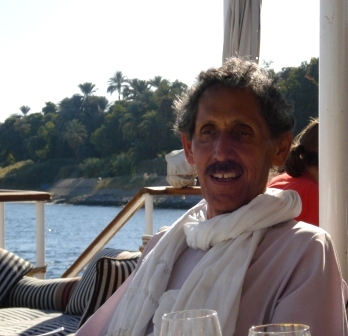The sudden calm aboard the dahabiyya was a shock. Nothing but the blue-silver water of the Nile, passing alongside palms and desert hills, with the silence of wave slurps, birds and, far off in the distance, on shore, a call for Muslim prayer. After three days of running through temples and tombs in Luxor, hassled by even the guides for a bit of baksheesh (tips), and called out to by every walking male, nothing could be higher on my list for the remainder of my trip to Egypt than this calm oasis of a luxury boat calmly taking its time to get down the Nile to Aswan, the site of the famous dam.
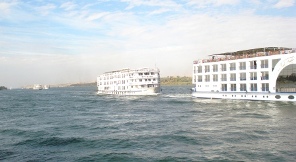
It was clearly not their philosophy from the beginning. We drove off at a leisurely pace from Luxor (where the couple has a guest house), past checkpoints and mud brick villages, and once in the town of Esna, we moved through the local market, en route to the boats, passing men forging iron wheels in fire at blackened kilns, women clutching chickens by the neck, and more than a few children running in tattered brown shirts along the dusty paths.
Around the bend from a temple, we saw them: the four El Nil boats, sleek wooden ships, flanked by two red-and-white Latin sails, with long 50 meter pine decks of comfortable salon couches, and below--we took our time investigating!--cabins of pristine white, the deluxe mattresses made by hand out of fluffed Egyptian cotton ("You should see the cloud of white cotton, flying up on deck, while the mattress men sew!"), topped with white duvets imported from France. Each cabin was decorated differently; some with portraits of Ottoman sultans before the banks of the Nile; others with sketches of women posing in languor. It was hard to choose the cabin I wished: the one that would face the rising sun to the east or the setting sun to the west, and I opted finally for western sunlight bright on a handsome mamluk's mustached face, reflected in a round crafted white mirror.
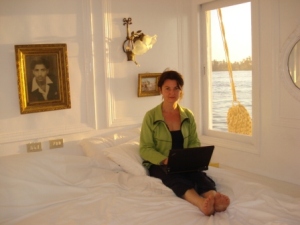
All this thanks to Napoleon! It was Napoleon who had the harebrained idea to invade Egypt in 1798--a trip that failed in one sense (Napoleon's men were chased out of Egypt, and many drowned in the Nile), but succeeded in another: not only did Napoleon become famous as a general, but Egypt was put on the Occidental map. The rage for all things Egyptian--from enameled sphinx-leg tables to obelisks to the sun god Ra--led to Egytomania, the first dedicated study and subsequent excavation of the ancient Pharoanic culture.
It also led to the dahabiyya. The artists and the posh, excited, also set off to visit Egypt--the closest "oriental" country to Europe--and as there were no roads, they had to go by boat. Hence the birth of the boat of "gold" (dahab), perhaps styled after Ottoman fleets, or the Pharoahs' mystical solar barks with golden hull. Gustave Flaubert and Maxime du Camp journeyed down the Nile in a dahabiyya (a journey which sparked Flaubert's "The Temptation of St. Antoine", alive with Egyptian mythology), and so did a god-inspired Florence Nightingale, invited by her wealthy patrons to take what was then the most elite form of travel in Africa. "I would never go in a steamer on the Nile!" said Florence Nightingale. "I go by dahabiyya and ass!"
The Nour El Nil dahabiyya trip is modeled after these leisure trips of old. Like Osiris coming back to life with the aid of his devoted wife Isis, who reconstructed him from his fourteen parts, Enrique, Eleanore and Mamdouh had the idea to revive the defunct ship, this rival mode to the steamer, and take this century's traveler in its wake. This latest introduction to the tourist trade of Egypt initially kept a low profile--passed on principally by word of mouth (even today on this trip, it seemed most of the passengers "knew" someone)--until the last couple years, when at least half dozen companies decided to copy cat, a crowding of the industry that is clearly a touchy point with the original inventors. "They take our idea, and make it into a money-venture. While we do it for love. To give people the experience of a real Egypt."
The real Egypt, for Enrique, means the villages ("look at the carving on that door!"), the fields, the banks of the Nile. The first morning, Enrique collected a few of us from the four dahabiyyas docked together (far from the cruise ships, among the leafy palms and mango trees) for a walk through the grasses of the eastern bank.
"Nature!" he exclaimed, waving his hands at the bean plants, banana trees and canals cutting through the fields. We walked along a dirt path, listening to the sugar cane crackling in the morning-fresh breeze, a sound intensified when Enrique asked me to close my eyes, and took my hand so I could walk blind, to listen to the intermittent rush of reeds and birds.
"And here is the oldest extant city of Egypt!" El Kab, an arena-sized wall encircling grass, made of mud-bricks, dating from at least 3000 BC.
After a slip in the Nile mud (my own), it was back to the boat for fresh orange juice and a breakfast of home-made bread made from Eleonore's home-grown wheat (rivaling the round loaves the village women had been baking in a hut we visited, each flat lump of dough sunning next to its fellows), accompanied by 3.5 minute boiled eggs, Egyptian feta cheese, and French crepes with guava jam. The only downside: the servant who brings the coffee--one of the thirteen staff serving the ten guests--also takes a spoon and stirs the cream.....
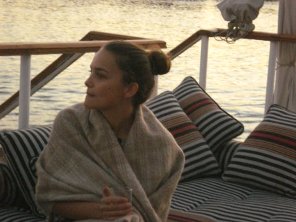
Then there was the Swiss German elderly couple, the husband who had traveled the world for his fashion jewelry business (now sold to Cartier) and woke always with a wild laugh--ready to gesture "Perfect! Just perfect!" at every new surprise, rubbing his hands briskly in the bright morning sun.
And, assorted quietly on the divans on the deck, with various books, an American family from New York City: the little freckled girl in long braids and huge polka dot ribbons, matching her pink-blue sunglasses, and her bright-red haired twelve year old brother, reading a mystery novel about a boy who stole lightning from the Greek gods.
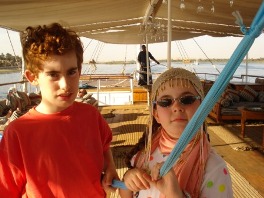
We were to spend five days together, and from the beginning each tended to find his or her own spot in the sun on the spacious deck, inbetween lunch and dinner, and then gather closely at the ceremonious meals: the farm duck and lettuce greens freshly bought from the farmers along the banks of the Nile, the staff of thirteen, dressed in long grey galabiahs, cooking them in the galley.
These young men--strikingly handsome, may I add--came from the local villages of Luxor and loved their jobs, they told me, always smiling, as they graciously stood by the tables to pour us Egyptian wine (grapes from the delta) or, at sunset, Egyptian black tea, served with date cakes. And inbetween meals, served on silver trays: goblets of guava juice with karkadai (hibiscus), the pink floating into the white foam.
Of course, as in an Agatha Christie novel, ten strangers put together in a closed environment (ship or train) leads to new alliances, intrigues, and a bit of unexpected drama. I myself was delighted with a surprise friendship with the little girl, who I saw each morning, risen well before the others, sitting calmly with a bright smile at the pine table, hands folded before her in her blue parka. 
I also enjoyed being taught backgammon one brisk chilly evening by her brother, who gaily said "Oh no!" and clapped his hands to his ears each time one of us forgot which direction we were going. The sun set as we finished.
The highlight: a long sensuous Nubian dance with Mohammed, one of the staff, at the bonfire on the banks of the Nile, at New Year's, under a black sky of stars, the rhythm of chants and drums going off into the darkened palms, the flames rising on the sand.
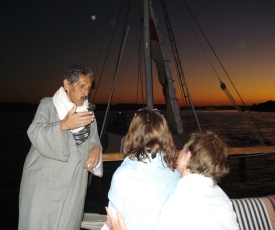
.............................................
Or takes the occasional walk along the banks, to an ancient Ptolemaic temple, replete with images of Horus carved in the stone. Yesterday, it was a walk through the sand, to the quarries, from which sandstone was taken for the temples in Luxor, the signs of the axe fresh in the rock, passing along the way small cave-tombs covered with hieroglyphics, their mouths open to a bright blue Nile. This morning, it was a hike through the desert, miles of rock and sand, with the occasional carving of a carved gazelle, and, what was the big surprise, a field with little boys playing soccer on the sand. "Hard work," said Randall, a bemused Yale graduate from the other boat who joined the boys. "Your bare feet scrape on the rocks, and the field changes with the wind!"
We learn that ancient Egypt was not, as commonly thought, a morbid culture devoted to the dead (mummy-land!) but actually a culture obsessed with life: the paintings on the walls are of everyday pleasures, men holding the hands of their children, wives caressing their husbands, farmers delighting in food and wine.
One is also reminded that the Nile is the longest river in the world--crossing nine countries--and one is tempted--in a moment of heedlessness--to take it all the way to Uganda!
"Not possible," explains Eleanore. "Today there is a dam in Aswan."
Every passenger--when we landed in Aswan--waxed ecstatically about the trip, from the Hong Kong bankers on the other ship to the little boy Sacha from Switzerland, who liked to click his heels at his donkey and whisper to it as if it were his horse.
"I like to make people happy," said Enrique, ever-grinning, with a chuckle, as he waved his arms open, perched on his cane, the Nile wide before him.
